Study on the Numerical Simulation of the SLM Molten Pool Dynamic Behavior of a Nickel-Based Superalloy on the Workpiece Scale
Abstract
:1. Introduction
1.1. Numerical Simulation of SLM Molten Pool Dynamic Behavior on the Particle Scale
1.2. Numerical Simulation of SLM Molten Pool Dynamic Behavior on the Workpiece Scale
2. Mathematical and Numerical Modeling
2.1. Dynamic Behavior Control Equations of the SLM Molten Pool Based on the Workpiece Scale
2.1.1. Momentum Conservation Equation
2.1.2. Energy Conservation Equation
2.1.3. Mass Conservation Equation
2.2. Gaussian Body Heat Source Considering Laser Reflection between Particles
2.3. Vaporization Heat Loss Model
2.4. Equivalent Thermal Property Parameters Based on the Formation State
2.4.1. Equivalent Density and Specific Heat Capacity Based on the Formation State
2.4.2. Equivalent Thermal Conductivity Based on the Forming State
2.5. Numerical Solution of the Dynamic Behavior of the SLM Molten Pool Based on the Workpiece Scale
3. Results and Discussion
3.1. Experimental Verification of the Inconel 718 Nickel-Based Superalloy by the SLM Process
3.1.1. Calculation Parameters and Mesh Model
3.1.2. Comparison of Simulation and Experimental Solidified Track Sizes
3.2. Analysis of the SLM Process of the Inconel 718 Nickel-Based Superalloy
3.2.1. Calculation Parameters and Mesh Model
3.2.2. Influence of the Laser Power on the Solidified Track Width
3.2.3. Influence of the Scanning Speed on the Solidified Track Width
4. Conclusions
- (1)
- The more reasonable and comprehensive equivalent processing models included the following. Based on the smooth vaporization pressure model, the liquid metal vaporization heat loss models were established. To characterize the transformation of the powder layer state (particle state, liquid state and solid state) in the SLM process, the equivalent density, specific heat capacity, and thermal conductivity models based on the formation state were established.
- (2)
- The SLM single-pass formation of the Inconel 718 alloy process was calculated. The simulation and experimental solidified track sizes were in good agreement, and the feasibility of the SLM molten pool dynamics model was verified.
- (3)
- The influences of different process parameters (laser power, scanning speed) on the SLM formation of the Inconel 718 alloy were calculated and analyzed. Comparing the simulation and the experimentally determined solidified track widths, the two agreed well, and the results showed that, as a rule, the width increased linearly with the laser power and decreased linearly with the scanning speed.
- (4)
- Key to the current metal additive manufacturing process is that the geometry of the workpiece has an important influence on the thermal-melt-stress evolution. To analyze the influence of the “heat transfer process-geometry-stress distribution” on the quality of the workpiece using the molten pool dynamics model, the thermal load under different process parameters must be obtained based on the model discussed here and be introduced into the stress calculation of the workpiece in a reasonable way.
- (5)
- The complex thermophysical interactions existing in the SLM process often occur in a very short period of time and on a microscopic scale, such that the microstructure of the workpiece is greatly affected by the SLM process. Therefore, predicting the evolution behavior of an SLM solidification structure under different process parameters is also an important direction to study the “microstructure-molten pool-performance” of SLM parts.
Author Contributions
Funding
Acknowledgments
Conflicts of Interest
References
- Wang, H.Y.; An, Y.Q.; Li, C.Y.; Chao, B.; Ni, Y.; Liu, G.B. Research progress of Ni-based superalloys. Mater. Rev. 2011, 25, 482–486. [Google Scholar]
- Xiao, X.; Xu, H.; Qin, X.Z.; Guo, Y.A.; Guo, J.T.; Zhou, L.Z. Thermal fatigue behaviors of three cast nickel base superalloys. Acta Metall. Sin. 2011, 47, 1129–1134. [Google Scholar]
- Qi, H. Review of Inconel 718 alloy: Its history, properties, processing and developing substitutes. J. Mater. Eng. 2012, 8, 92–100. [Google Scholar]
- Liu, Y.C.; Guo, Q.Y.; Li, C.; Mei, Y.P.; Zhou, X.S.; Huang, Y. Recent progress on evolution of precipitates in Inconel 718 superalloys. Acta Metall. Sin. 2016, 52, 1259–1266. [Google Scholar]
- Yang, Q.; Lu, Z.L.; Huang, F.X.; Li, D.C. Research on status and development trend of laser additive manufacturing. Aeronaut. Manuf. Technol. 2016, 59, 26–31. [Google Scholar]
- Jia, X. Research on the flow field and mass transfer of tiny molten pool during selective laser melting of Inconel 718. Master’s Thesis, Harbin Institute of Technology, Harbin, China, 2017. [Google Scholar]
- Yadroitsev, I.; Gusarov, A.; Yadroitsava, I.; Smurov, I. Single track formation in selective laser melting of metal powders. J. Mater. Process. Tech. 2010, 210, 1624–1631. [Google Scholar] [CrossRef]
- Huan, J.; Tian, Z.J.; Liang, H.X.; Xie, D.Q.; Shen, L.D.; Lv, F. Study on forming process and surface topography of Titanium alloy by selective laser melting process. Appl. Laser 2018, 38, 183–189. [Google Scholar]
- Kruth, J.P.; Levy, G.; Klocke, F.; Childs, T.H.C. Consolidation phenomena in laser and powder-bed based layered manufacturing. CIRP Ann. 2007, 56, 730–759. [Google Scholar] [CrossRef]
- Strano, G.; Hao, L.; Everson, R.M.; Evans, K.E. Surface roughness analysis, modelling and prediction in selective laser melting. J. Mater. Process. Technol. 2013, 213, 589–597. [Google Scholar] [CrossRef]
- Liu, B.T.; Tian, C.; Zhang, A.P. Forming process of selective laser melting of nickel-based superalloy. J. Heilongjiang Univ. Sci. Technol. 2016, 26, 138–142. (In Chinese) [Google Scholar]
- Cao, L.; Liao, D.M.; Sun, F.; Chen, T. Numerical simulation of cold-lap defects during casting filling process. Int. J. Adv. Manuf. Technol. 2018, 97, 2419–2430. [Google Scholar] [CrossRef]
- Cao, L.; Sun, F.; Chen, T.; Tang, Y.L.; Liao, D.M. Quantitative prediction of oxide inclusion defects inside the casting and on the walls during cast-filling processes. Int. J. Heat Mass Transf. 2018, 119, 614–623. [Google Scholar] [CrossRef]
- Francois, M.M.; Sun, A.; Wayne, K.E.; Henson, N.J.; Tourret, D.; Bronkhorst, C.A. Modeling of additive manufacturing processes for metals: Challenges and opportunities. Curr. Opin. Solid State Mater. Sci. 2017, 21, 198–206. [Google Scholar] [CrossRef]
- Markl, M.; Körner, C. Multiscale modeling of powder bed-based additive manufacturing. Annu. Rev. Mater. Res. 2016, 46, 93–123. [Google Scholar] [CrossRef]
- Gürtler, F.J.; Karg, M.; Leitz, K.H.; Schmidt, M. Simulation of laser beam melting of steel powders using the three-dimensional volume of fluid method. Phys. Procedia 2013, 41, 874–879. [Google Scholar] [CrossRef]
- Khairallah, S.A.; Anderson, A.T.; Rubenchik, A.; King, W.E. Laser powder-bed fusion additive manufacturing: Physics of complex melt flow and formation mechanisms of pores, spatter, and denudation zones. Acta Mater. 2016, 108, 36–45. [Google Scholar] [CrossRef] [Green Version]
- Dai, D.; Gu, D.D. Thermal behavior and densification mechanism during selective laser melting of copper matrix composites: Simulation and experiments. Mater. Des. 2014, 55, 482–491. [Google Scholar] [CrossRef]
- Michaleris, P. Modeling metal deposition in heat transfer analyses of additive manufacturing processes. Finite Elem. Anal. Des. 2014, 86, 51–60. [Google Scholar] [CrossRef]
- Voisin, T.; Calta, N.P.; Khairallah, S.A.; Forien, J.; Balogh, L.; Cunningham, R.W. Defects-dictated tensile properties of selective laser melted Ti-6Al-4V. Mater. Des. 2018, 158, 113–126. [Google Scholar] [CrossRef]
- Lee, Y.S.; Zhang, W. Mesoscopic simulation of heat transfer and fluid flow in laser powder bed additive manufacturing. In Proceedings of the Annual International Solid Freeform Fabrication Symposium, Austin, TX, USA, 10–12 August 2015. [Google Scholar]
- Panwisawas, C.; Qiu, C.; Anderson, M.J.; Sovani, Y.; Turner, R.; Attallah, M.M. Mesoscale modelling of selective laser melting: Thermal fluid dynamics and microstructural evolution. Comp. Mater. Sci. 2017, 126, 479–490. [Google Scholar] [CrossRef]
- Xiao, B.; Zhang, Y. Marangoni and buoyancy effects on direct metal laser sintering with a moving laser beam. Numer. Heat Transf. A-Appl. 2007, 51, 715–733. [Google Scholar] [CrossRef]
- Gusarov, A.V.; Smurov, I. Modeling the interaction of laser radiation with powder bed at selective laser melting. Phys. Procedia 2010, 5, 381–394. [Google Scholar] [CrossRef] [Green Version]
- Yuan, P.; Gu, D.D. Molten pool behaviour and its physical mechanism during selective laser melting of TiC/AlSi10Mg nanocomposites: Simulation and experiments. J. Phys. D-Appl. Phys. 2015, 48, 035303. [Google Scholar] [CrossRef]
- Cao, L.; Sun, F.; Chen, T.; Teng, Z.H.; Tang, Y.L.; Liao, D.M. Numerical simulation of liquid-solid conversion affecting flow behavior during casting filling process. Acta Metall. Sin. 2017, 53, 1521–1531. [Google Scholar]
- Yang, J.; Wang, F. 3D finite element temperature field modelling for direct laser fabrication. Int. J. Adv. Manuf. Tech. 2009, 43, 1060–1068. [Google Scholar] [CrossRef]
- Cao, L.; Liao, D.M.; Lu, Y.Z.; Chen, T. Heat transfer model of directional solidification by LMC process for superalloy casting based on finite element method. Metall. Mater. Trans. A 2016, 47, 4640–4647. [Google Scholar] [CrossRef]
- King, W.E.; Anderson, A.T.; Ferencz, R.M.; Hodge, N.E.; Kamath, C.; Khairallah, S.A. Laser powder bed fusion additive manufacturing of metals; physics, computational, and materials challenges. Appl. Phys. Rev. 2015, 2, 041304. [Google Scholar] [CrossRef]
- Qiu, C.; Panwisawas, C.; Ward, M.; Basoalto, H.C.; Brooks, J.W.; Attallah, M.M. On the role of melt flow into the surface structure and porosity development during selective laser melting. Acta Mater. 2015, 96, 72–79. [Google Scholar] [CrossRef] [Green Version]
- Hagelin-Weaver, H. Surface Science: Foundations of Catalysis and Nanoscience. J. Nanopart. Res. 2002, 4, 575–576. [Google Scholar] [CrossRef]
- Pang, S.Y.; Hirano, K.; Fabbro, R.; Jiang, T. Explanation of penetration depth variation during laser welding under variable ambient pressure. J. Laser Appl. 2015, 57, 022007. [Google Scholar] [CrossRef]
- Dai, K.; Shaw, L. Thermal and mechanical finite element modeling of laser forming from metal and ceramic powders. Acta Mater. 2004, 52, 69–80. [Google Scholar] [CrossRef]
- Zhang, L.; Wu, W.H.; Lu, L.; Ni, X.Q.; He, B.B.; Yang, Q.Y. Effect of heat input parameters on temperature field in Inconel 718 alloy during selective laser melting. J. Mater. Eng. 2018, 46, 29–35. [Google Scholar]
- Wu, T.; Liu, B.T.; Liu, J.H. Study on nickel-based superalloy selective laser melting process parameters. J. Heilongjiang Univ. Sci. Tech. 2015, 25, 361–365. [Google Scholar]
- Liu, B.Y. Cyclic aging behavior of TC4 powder and the influence on properties of components built by SLM. Master’s Thesis, Shenyang Aerospace University, Shenyang, China, 2018. [Google Scholar]
- Gibson, I.; Rosen, D.; Stucker, B. Additive Manufacturing Technologies: Rapid Prototyping to Direct Digital Manufacturing; Springer: Heidelberg, Germany, 2010. [Google Scholar]
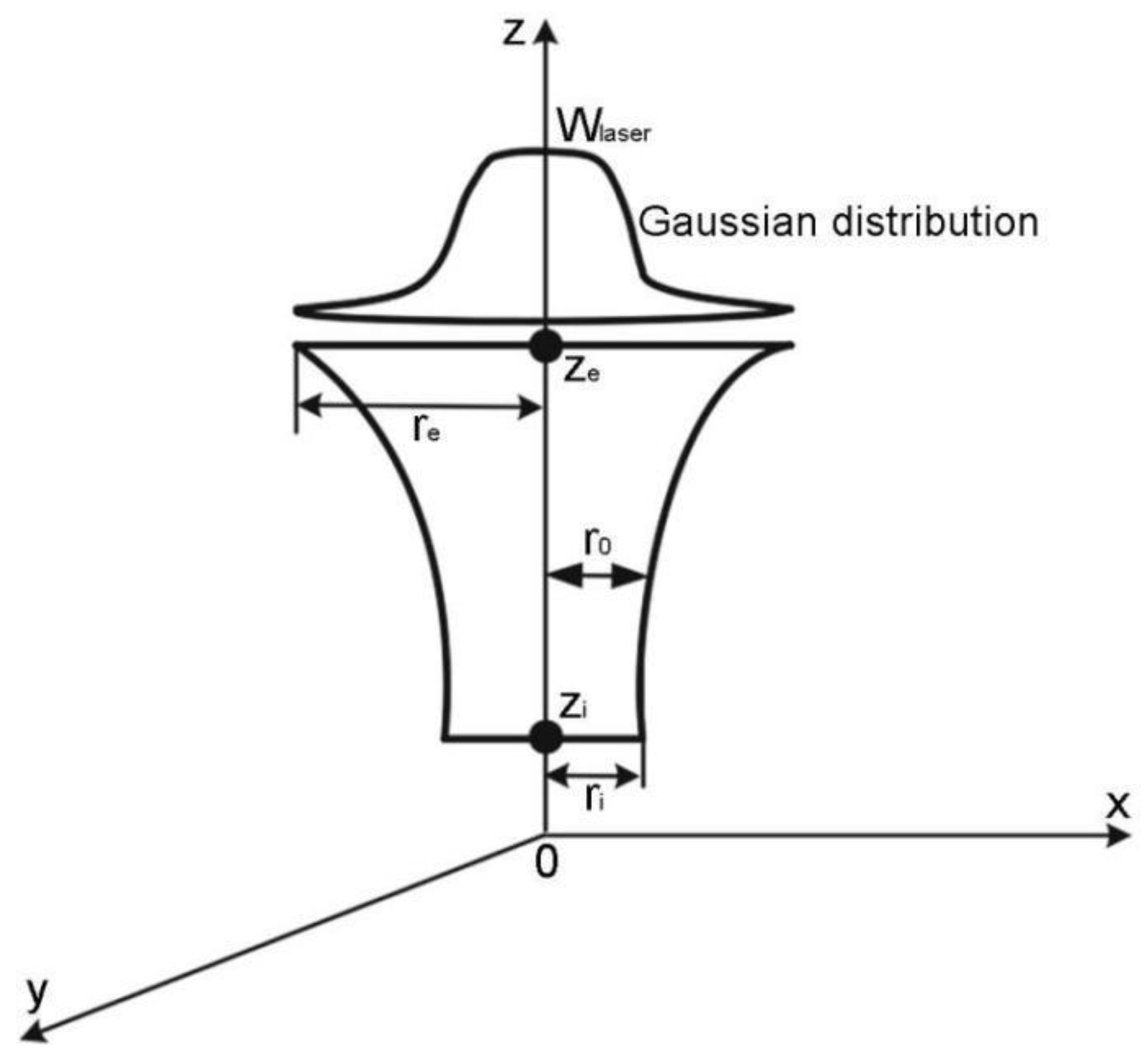


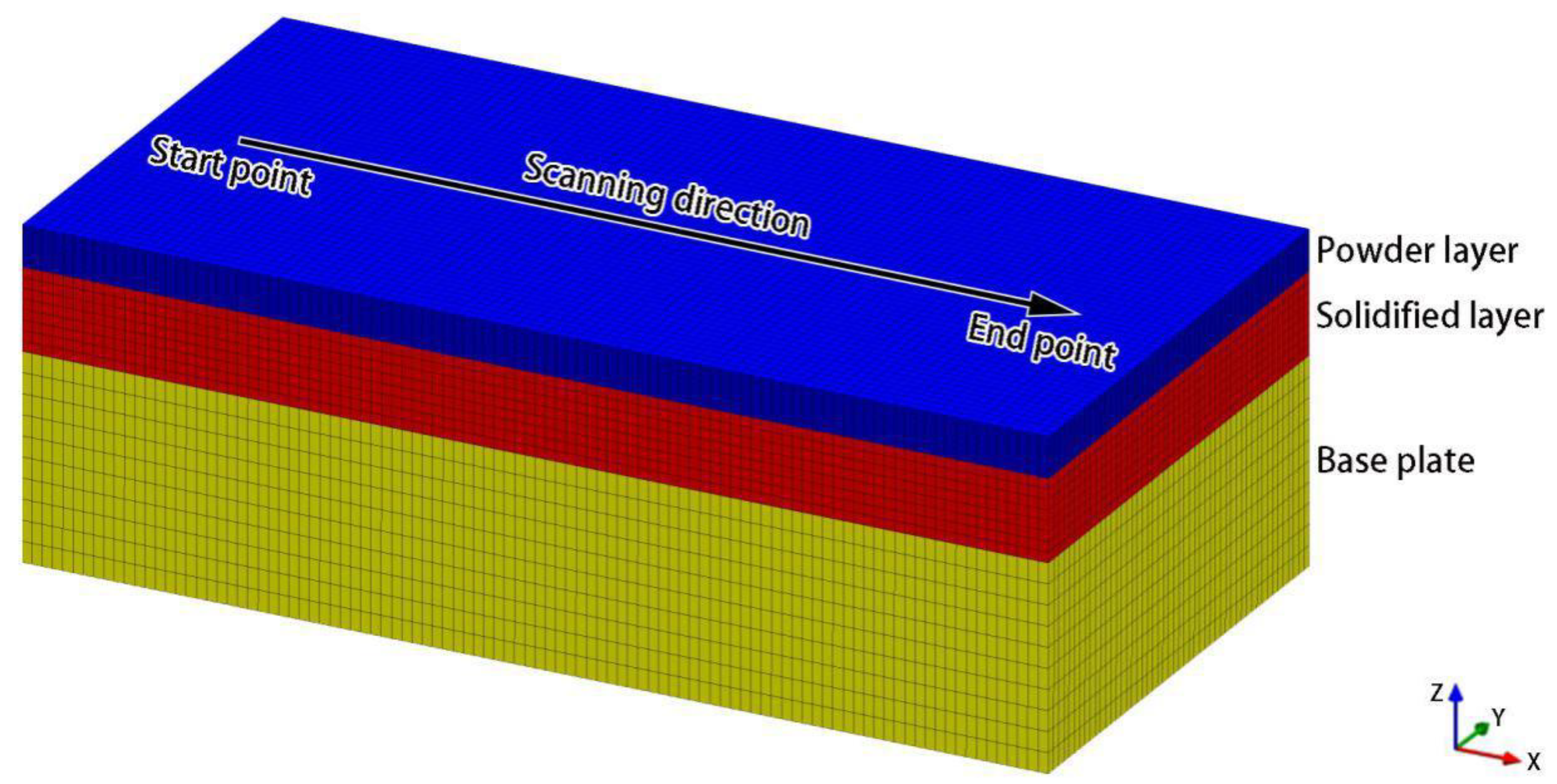


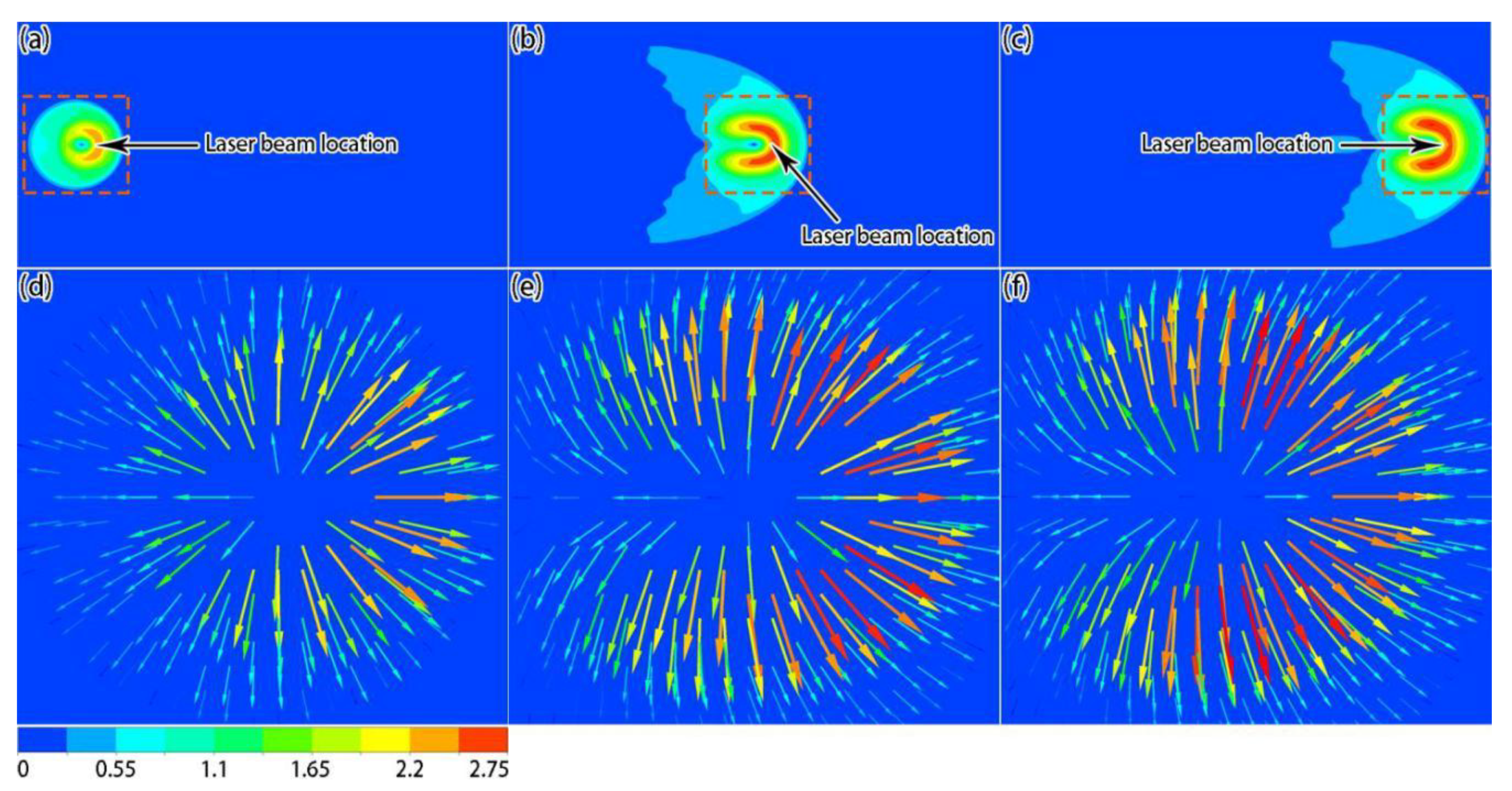

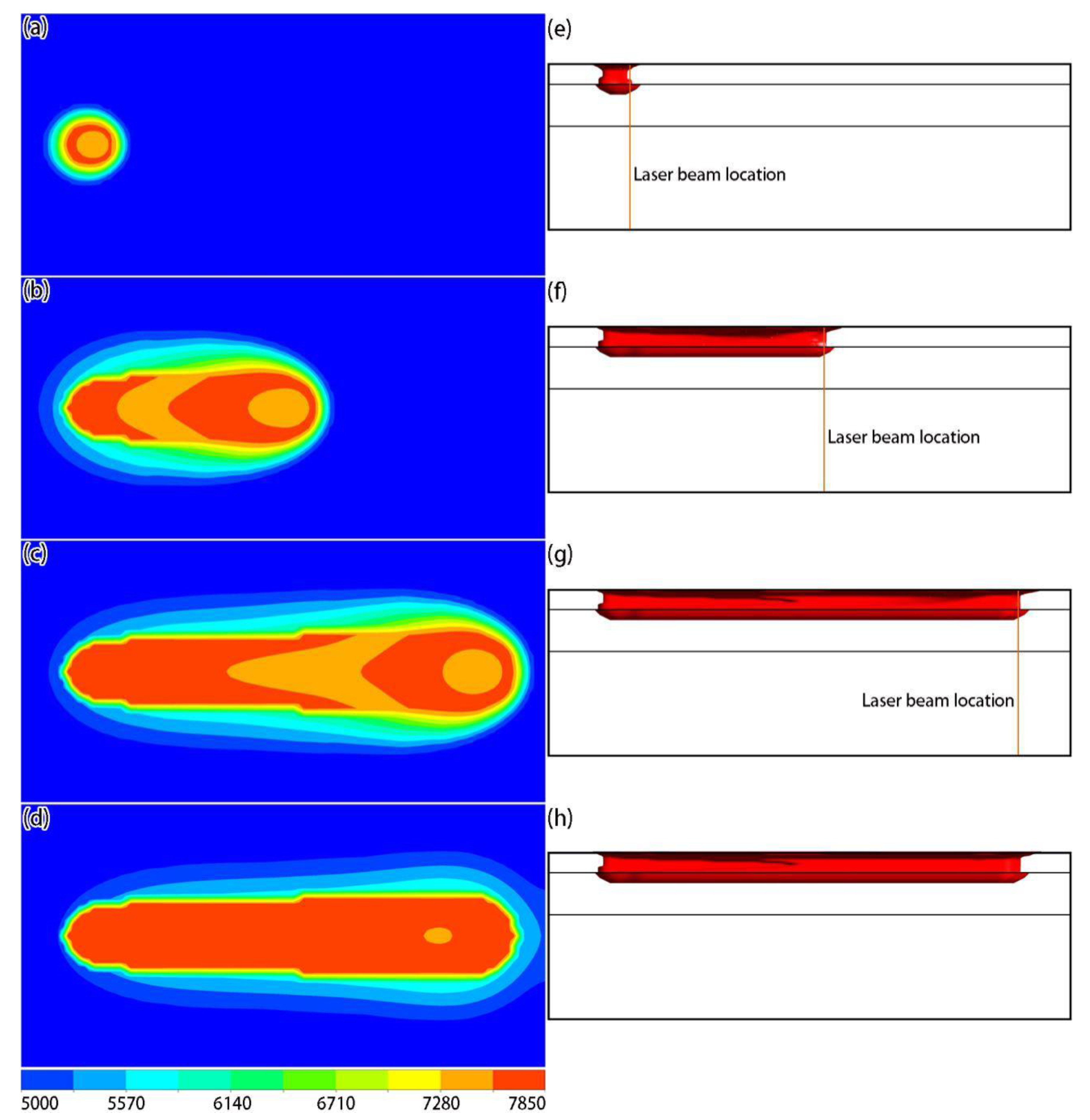



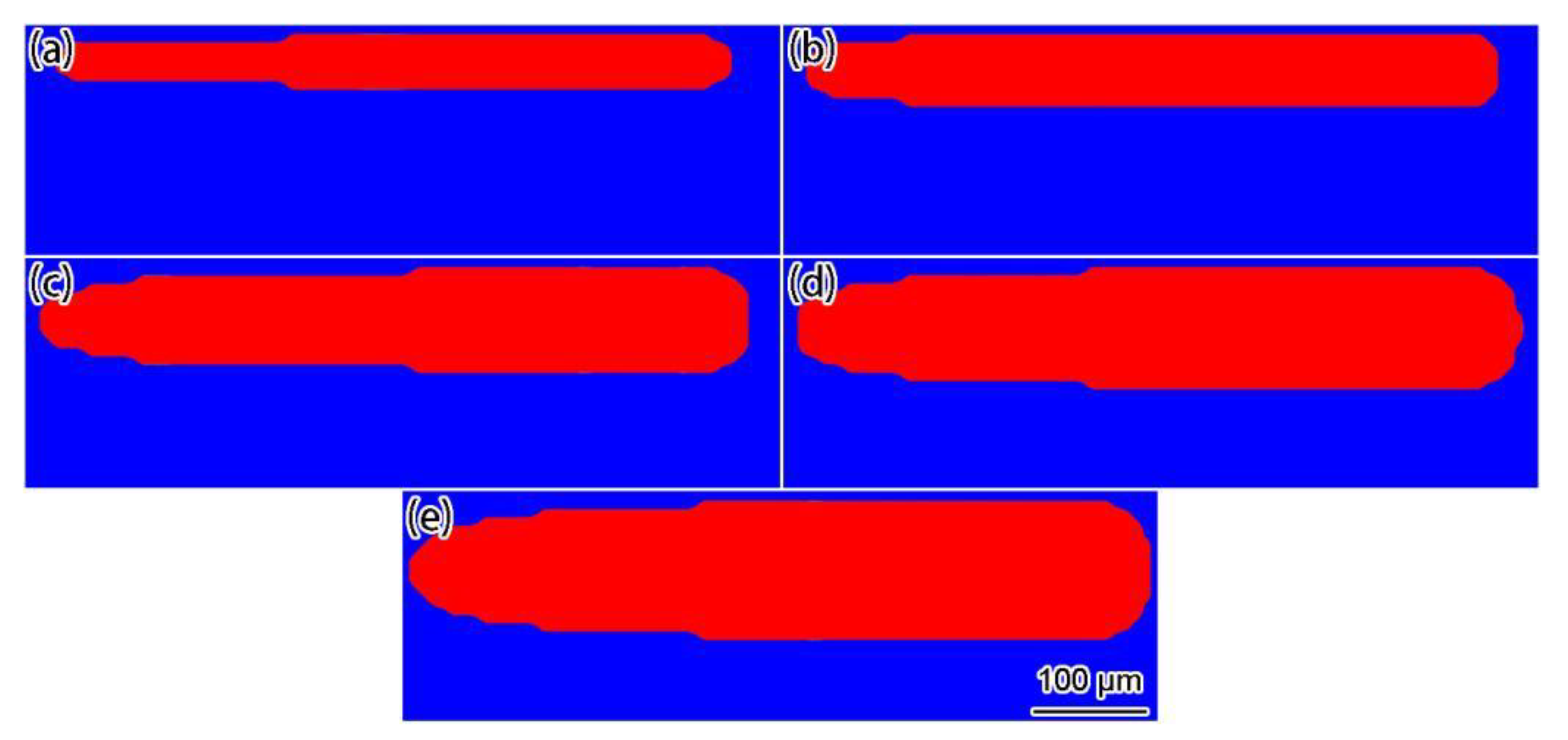
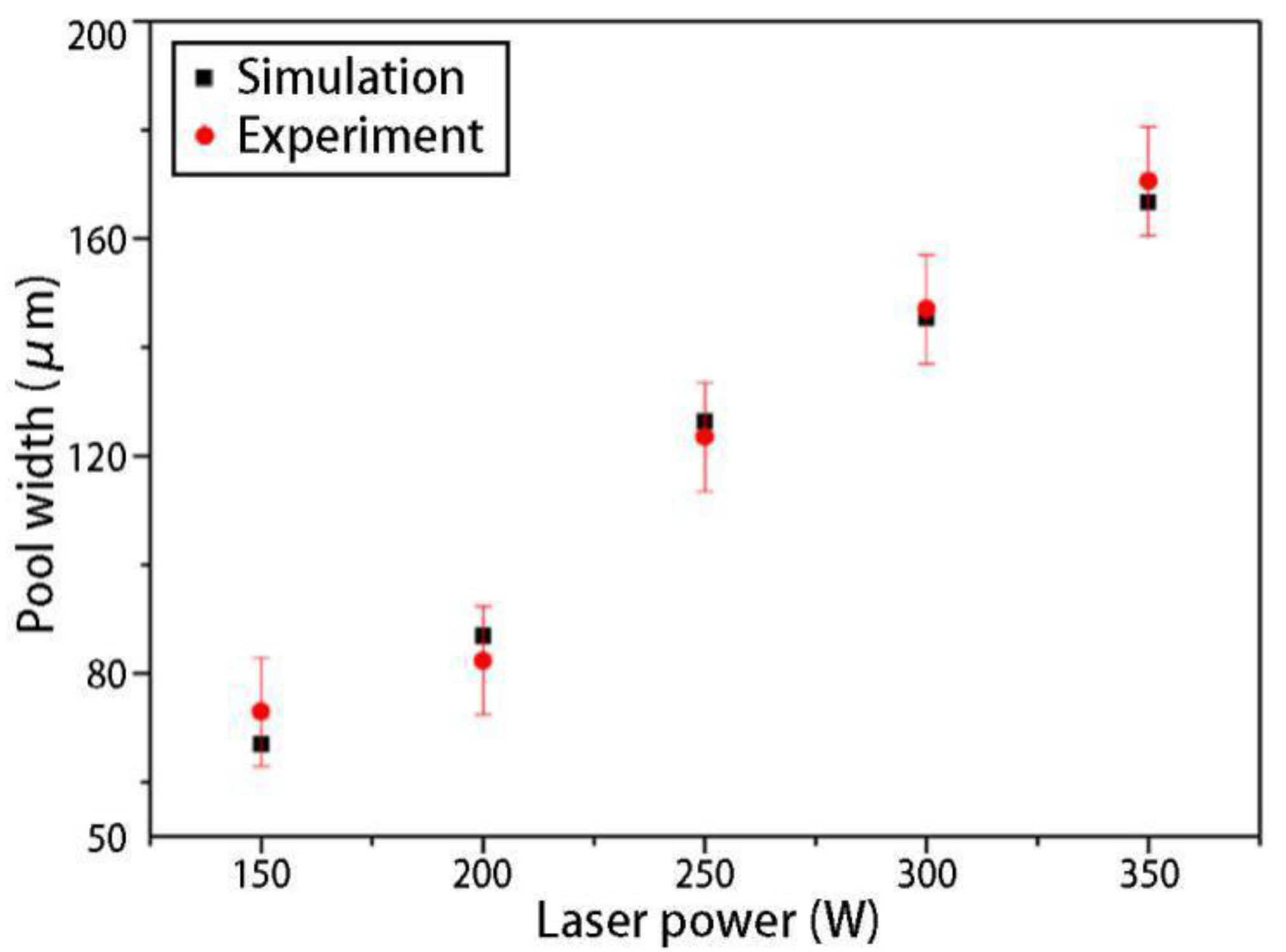
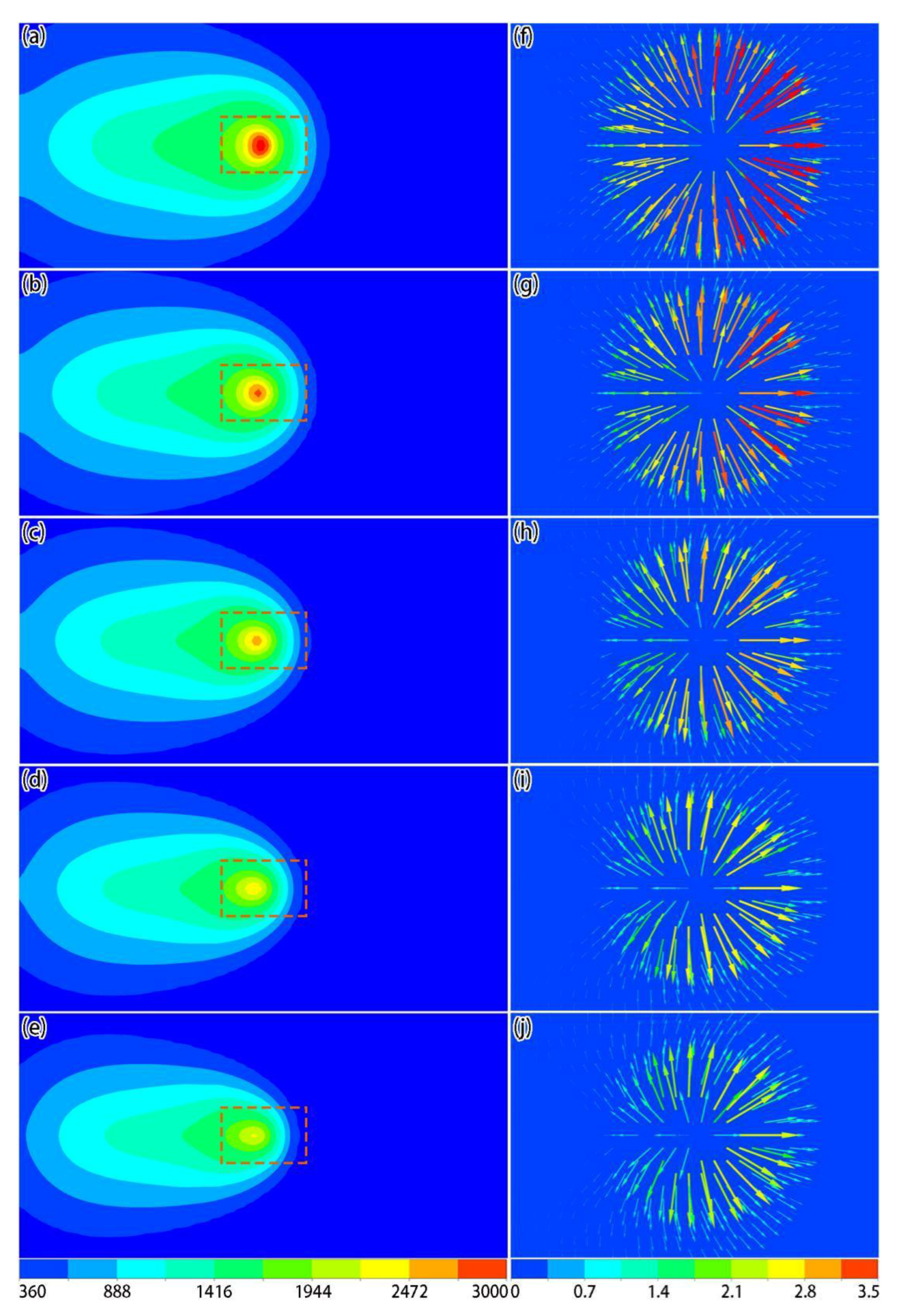
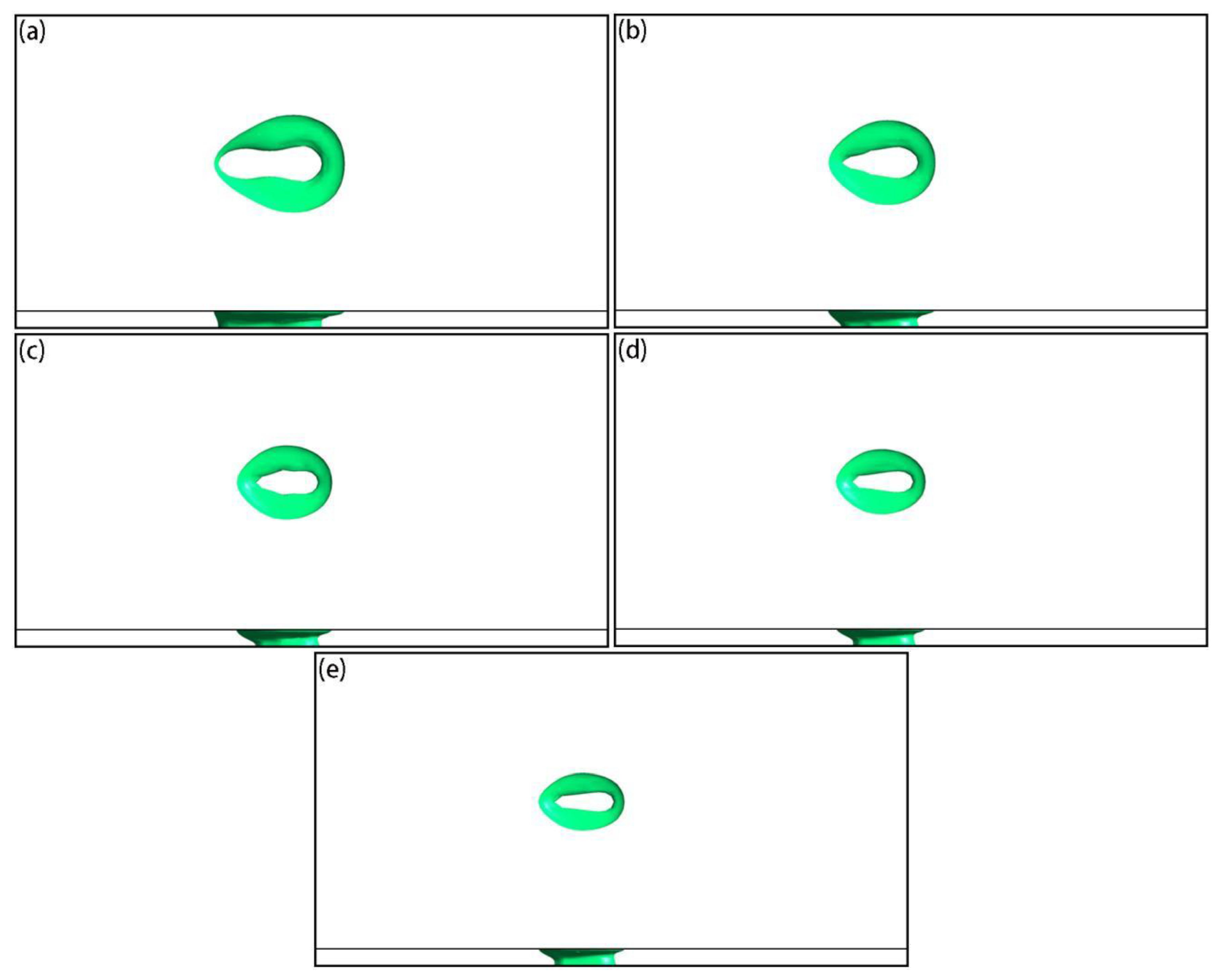

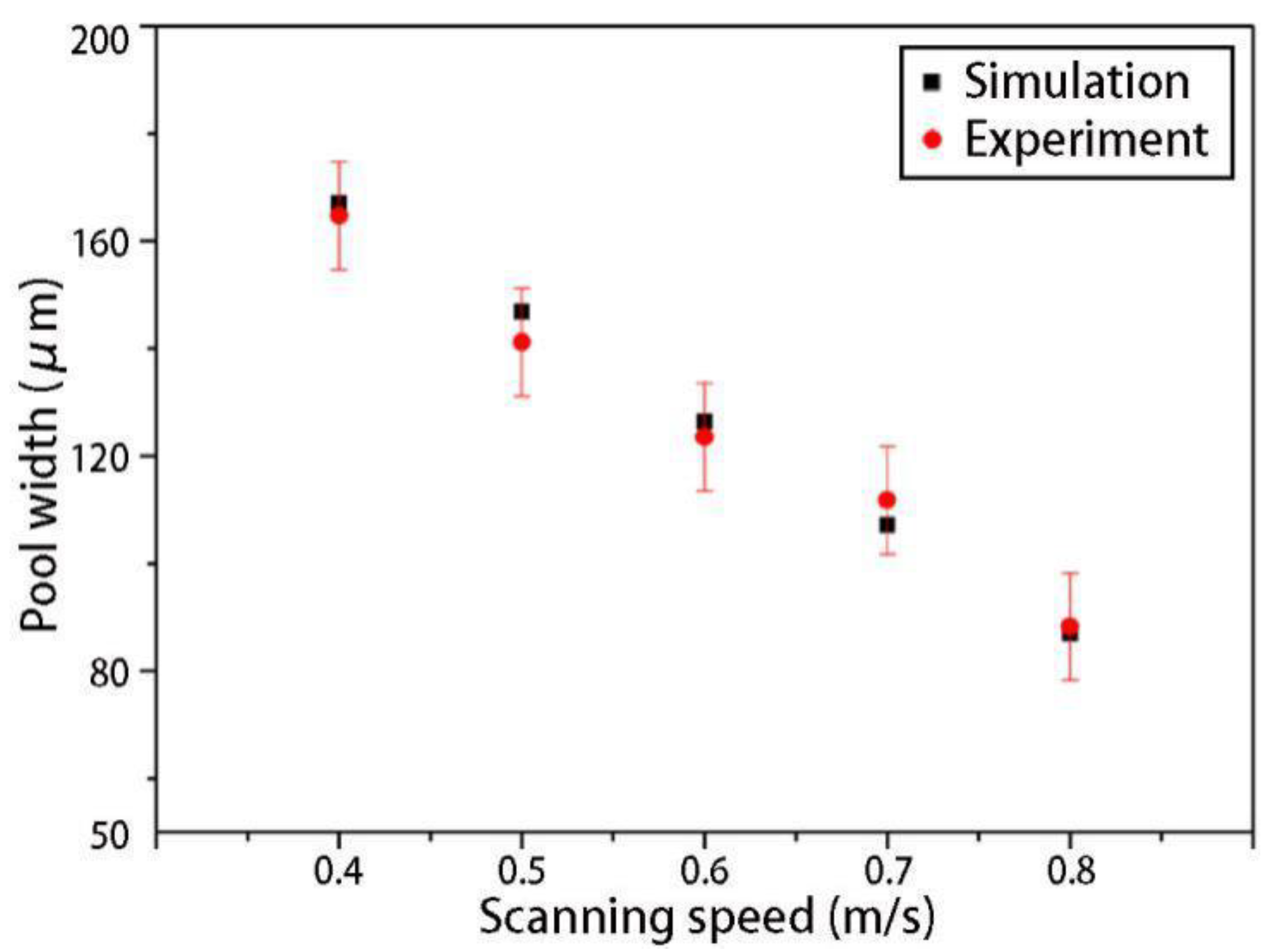
| Parameter | Value |
|---|---|
| Density, kg/m3 | 8250 (298 K) − 7488 (1373 K) − 7803 (1638 K) − 7378 (2000 K) − 6470 (2773 K) |
| Solidus temperature, K | 1373 |
| Liquidus temperature, K | 1638 |
| Vaporization temperature, K | 3000 |
| Latent heat of melting, J/kg | 2.19 × 105 |
| Latent heat of vaporization, J/kg | 7.34 × 106 |
| Specific heat capacity, J/(kg·K) | 760 |
| Surface tension coefficient with temperature change rate, N/(m·K) | −3.24 × 10−4 |
| Molecular mass, kg | 9.9134 × 10−26 |
| Thermal conductivity, W/(m·K) | 11.03 (298 K) − 28.01 (1373 K) − 27.86 (1638 K) − 45.72 (2773 K) |
| Dynamic viscosity, Pa·s | 0.021 (1373 K) − 0.009 (1638 K) − 0.005 (1933 K) − 0.002 (2773 K) |
| Parameter | Value |
|---|---|
| Initial porosity of the powder layer [36] | 0.4 |
| Laser absorption rate [33] | 0.36 |
| Laser spot diameter, m | 1.0 × 10−4 |
| Average particle diameter, m | 3.0 × 10−5 |
| Powder bed thickness, m | 4.0 × 10−5 |
| Laser power, W | 285 |
| Scanning speed, m/s | 0.96 |
| Density of the base plate, kg/m3 | 7200 |
| Thermal conductivity of the base plate, W/(m·K) | 28 |
| Specific heat capacity of the base plate, J/(kg·K) | 640 |
| Density of the gas phase, kg/m3 | 1.225 |
| Thermal conductivity of the gas phase, W/(m·K) | 0.0242 |
| Specific heat capacity of the gas phase, J/(kg·K) | 1006.43 |
| Convective/radiation heat transfer temperature of the surroundings, K | 300 |
| Convective heat transfer coefficient of the lower surface of the base plate and the upper surface of the powder layer, W/(m2·K) | 80 |
| Emissivity | 0.36 |
| Initial temperature, K | 353.15 |
| Stefan–Boltzmann constant, W/(m2·K4) | 5.67 × 10−8 |
| Boltzmann constant, J/K | 1.3806505(24) × 10−23 |
| Standard atmospheric pressure, Pa | 1.01325 × 105 |
| Parameter | Value |
|---|---|
| Laser spot diameter, m | 7.0 × 10−5 |
| Powder bed thickness, m | 3.0 × 10−5 |
| Laser power, W | 150, 200, 250, 300, 350 |
| Scanning speed, m/s | 0.4, 0.5, 0.6, 0.7, 0.8 |
© 2019 by the authors. Licensee MDPI, Basel, Switzerland. This article is an open access article distributed under the terms and conditions of the Creative Commons Attribution (CC BY) license (http://creativecommons.org/licenses/by/4.0/).
Share and Cite
Cao, L.; Yuan, X. Study on the Numerical Simulation of the SLM Molten Pool Dynamic Behavior of a Nickel-Based Superalloy on the Workpiece Scale. Materials 2019, 12, 2272. https://doi.org/10.3390/ma12142272
Cao L, Yuan X. Study on the Numerical Simulation of the SLM Molten Pool Dynamic Behavior of a Nickel-Based Superalloy on the Workpiece Scale. Materials. 2019; 12(14):2272. https://doi.org/10.3390/ma12142272
Chicago/Turabian StyleCao, Liu, and Xuefeng Yuan. 2019. "Study on the Numerical Simulation of the SLM Molten Pool Dynamic Behavior of a Nickel-Based Superalloy on the Workpiece Scale" Materials 12, no. 14: 2272. https://doi.org/10.3390/ma12142272




